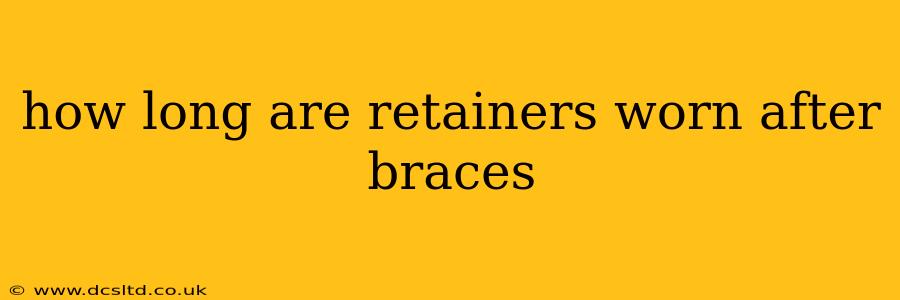Orthodontic treatment with braces is a significant commitment, but the journey doesn't end when your braces come off. The crucial next step is wearing a retainer, a device designed to maintain the beautifully straightened teeth achieved through your orthodontic treatment. But how long do you need to wear a retainer? The answer isn't a simple one-size-fits-all response; it depends on several factors. This comprehensive guide will delve into the specifics, answering your questions and helping you understand the importance of retainer wear.
How Long Do I Need to Wear a Retainer?
The duration of retainer wear is highly individualized. While some orthodontists recommend wearing a retainer full-time initially, transitioning to nighttime-only use after a few months, others might prescribe a different schedule based on your specific needs. Generally, the initial period of full-time wear can last anywhere from several months to a year. After this initial period, many patients transition to wearing their retainer only at night.
However, the crucial factor is dental stability. Your orthodontist will assess your teeth's stability and determine when you can safely reduce retainer wear. This assessment involves regular check-ups and monitoring for any signs of teeth shifting. Some individuals may need to wear their retainers indefinitely to prevent relapse, while others may only need them for a few years.
The key is consistent communication and collaboration with your orthodontist. They are the best resource to determine the appropriate duration of retainer wear for your particular situation.
What Happens If I Don't Wear My Retainer?
Failing to wear your retainer as prescribed can lead to teeth shifting back to their original positions—a phenomenon known as relapse. This means that all the time, effort, and expense invested in orthodontic treatment will be partially or completely undone. The severity of relapse depends on several factors, including the individual's age, the severity of the original misalignment, and the consistency of retainer use.
Relapse can be subtle or dramatic, affecting both the alignment and overall bite. While minor adjustments might be correctable with further orthodontic treatment, significant relapse often requires a more extensive and costly intervention.
What Are the Different Types of Retainers?
There are two main types of retainers:
-
Removable retainers: These are plastic appliances that fit over your teeth. They are generally more comfortable and easier to clean, but they require diligent wear for effectiveness. Losing or breaking a removable retainer is a risk, and it necessitates immediate contact with your orthodontist.
-
Fixed retainers: These are thin wires bonded to the back of your teeth. They are permanently cemented in place, providing constant and unobtrusive retention. While offering superior stability, they can be more difficult to clean and may increase the risk of damage to the teeth if not properly maintained.
Your orthodontist will recommend the type of retainer most suitable for your situation, considering factors such as your lifestyle, dental health, and the severity of your misalignment.
Can I Stop Wearing My Retainer After a Certain Amount of Time?
While some patients may eventually discontinue retainer wear after several years, it's crucial to consult your orthodontist. They will assess your teeth’s stability and advise you on whether it's safe to do so. Stopping prematurely can significantly increase the risk of relapse. In many cases, wearing a retainer at night, even years after your initial orthodontic treatment, is recommended to maintain long-term stability.
How Often Should I See My Orthodontist After Braces?
Following the removal of your braces, regular follow-up appointments with your orthodontist are vital. These appointments allow for monitoring the position of your teeth and addressing any issues that may arise. The frequency of these check-ups will vary depending on individual circumstances, but they are generally scheduled initially at intervals of several months.
Conclusion
Wearing a retainer is an integral part of maintaining the results of orthodontic treatment. While the exact duration of retainer wear is individual-specific, consistent communication with your orthodontist is paramount to ensuring the long-term success of your treatment. Remember, preventing relapse is far more efficient and cost-effective than correcting it later. Prioritizing retainer wear and regular check-ups will help safeguard your beautiful, healthy smile for years to come.
